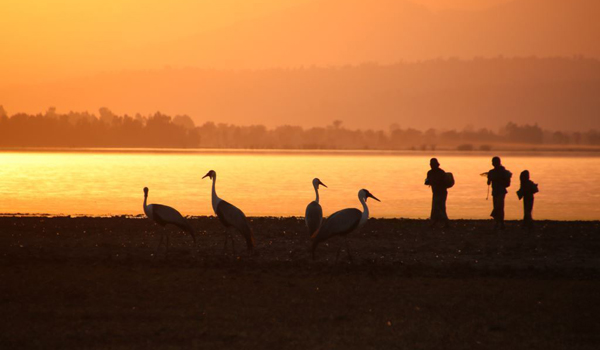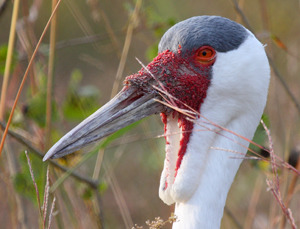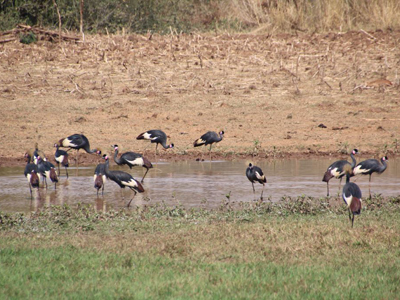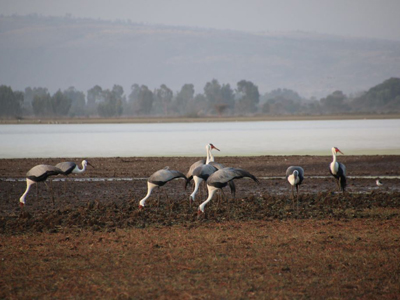
By Dr. George Archibald, ICF Co-founder & Senior Conservationist
The Silent Cranes
 While vociferousness is typically associated with cranes – “the trumpet in the orchestra of evolution” to quote Aldo Leopold – one of the largest of the 15 species, the Wattled Crane of Africa, is usually silent. Occasionally one might hear a piercing high-pitched Guard Call or Flight Call and on extremely rare occasions a short duet or Unison Call by a mated pair that lasts but a few seconds. If you are close to a pair or family of Wattled Cranes, one can frequently hear the low burr-like Contact Call, perhaps an expression of proximity and assurance.
While vociferousness is typically associated with cranes – “the trumpet in the orchestra of evolution” to quote Aldo Leopold – one of the largest of the 15 species, the Wattled Crane of Africa, is usually silent. Occasionally one might hear a piercing high-pitched Guard Call or Flight Call and on extremely rare occasions a short duet or Unison Call by a mated pair that lasts but a few seconds. If you are close to a pair or family of Wattled Cranes, one can frequently hear the low burr-like Contact Call, perhaps an expression of proximity and assurance.
During the first half of February I had the privilege of meeting 175 Wattled Cranes on the Ethiopian Plateau – the Roof of Africa, and the Great Rift Valley – the cradle of human evolution, that divides the Plateau from the northwest to the southeast. Bale Mountain National Park‘s Sanetti Plateau has been confirmed to provide nesting habitat for at least three pairs of these cranes. They arrive in July during the rainy season, and apparently nest after levels of wetlands peak in September, which marks the onset of the long period of drought. Apparently after the chicks fledge and many of the former wetlands are dry, the cranes leave. It has yet to be determined where they go. That question will be addressed during the next few years by doctoral candidate Hadis Tadele Desta of Addis Ababa University.
 About 220 km away, and about 1700 feet down from the confirmed nesting area, 133 Wattled Cranes were gathered at the Boyo Lake in the Great Rift Valley when we recently visited. When water levels peak in September, this lake is like a huge triangle of water measuring about two miles at the base and 10 miles in length. Then as the water drains and evaporates, vast shallows appear rife with emergent vegetation. Black Crowned Cranes (left) breed as water levels subside, but it remains unconfirmed if the basin provides breeding habitat for Wattled Cranes. That’s another mystery for Hadis to solve.
About 220 km away, and about 1700 feet down from the confirmed nesting area, 133 Wattled Cranes were gathered at the Boyo Lake in the Great Rift Valley when we recently visited. When water levels peak in September, this lake is like a huge triangle of water measuring about two miles at the base and 10 miles in length. Then as the water drains and evaporates, vast shallows appear rife with emergent vegetation. Black Crowned Cranes (left) breed as water levels subside, but it remains unconfirmed if the basin provides breeding habitat for Wattled Cranes. That’s another mystery for Hadis to solve.
The 94 million inhabitants of Ethiopia primarily are subsistence farmers in rural areas. The wetlands in the Bale Mountains and at Boyo Lake are heavily grazed by domestic animals as water levels recede. There is a possibility that overgrazing and trampling of nests might limit crane productivity. To my amazement, a circular grazing exclosure made of sticks and measuring about 30 feet in diameter and five feet high on a wetland on the Sanetti Plateau was selected as a nesting site for Wattled Cranes. Apparently the tall vegetation in the exclosure attracted the cranes, who must have somehow “helicoptered” into their nest! This interaction between domestic animals and cranes will be another topic for description by Hadis.
From Boyo Lake we ascended west up the escarpment to reenter the Plateau. The western portion of the Plateau gradually drops down to the border of South Sudan. This incline receives much more rain than the more level areas of the Plateau, and consequently supports lush forests that support wild coffee plants. This is where coffee was discovered when shepherds noticed their goats became lively when they ate coffee beans. Riparian lowlands and scattered basins that collect water provide wetlands where both Wattled and Black Crowned Cranes breed and remain through the dry season. Although we observed 10 pairs of Wattled Cranes, none had juveniles as might be expected towards the end of the dry season. A crane research team from Jimma University is undertaking a comprehensive study of the cranes and wetlands in that region to better define challenges.
 Ethiopia, just 1.6 times the size of Texas, has more than 856 species of birds compared to 639 in Texas – the lower 48’s most avian diverse state. To my amazement and delight, Ethiopians do not hunt birds. Those birds that have been able to adapt to a human-disturbed habitat thrive. To their benefit the Ethiopian cranes frequently forage on waste grains in farm fields, and search for insects in and around animal droppings in grazed areas. Generally speaking, except for damage from cranes to newly-germinated corn when farmers chase cranes from the fields, there is harmony.
Ethiopia, just 1.6 times the size of Texas, has more than 856 species of birds compared to 639 in Texas – the lower 48’s most avian diverse state. To my amazement and delight, Ethiopians do not hunt birds. Those birds that have been able to adapt to a human-disturbed habitat thrive. To their benefit the Ethiopian cranes frequently forage on waste grains in farm fields, and search for insects in and around animal droppings in grazed areas. Generally speaking, except for damage from cranes to newly-germinated corn when farmers chase cranes from the fields, there is harmony.
Unfortunately, industrialized farming threatens arable lands and the grazing areas to the demise of many of the subsistence farmers. And when wetlands are drained by huge machines, much less water is available for all. Consequently, management proposals based on research by Ethiopian colleagues are evolving for the conservation of wetlands and grazing lands, to the benefit for both humans and wildlife.
Although the magnificent Wattled Cranes are usually silent, through their regal presence they are ambassadors for a way of life that perhaps has flourished in this fascinating region where our ancestors have lived side by side with cranes for millions of years.
The expedition to Ethiopia was sponsored by my fellow-travelers, Joe Branch and Denny Geiler. Our combined thanks is extended to ornithologist Shimelis Aynalem, who organized the itinerary and guided us. Our skilled driver, Samuel Bekele, deserves special mention, as do our hosts at various places, especially Tariku Mekonnen and Abebayehu Alicho in Jimma.
